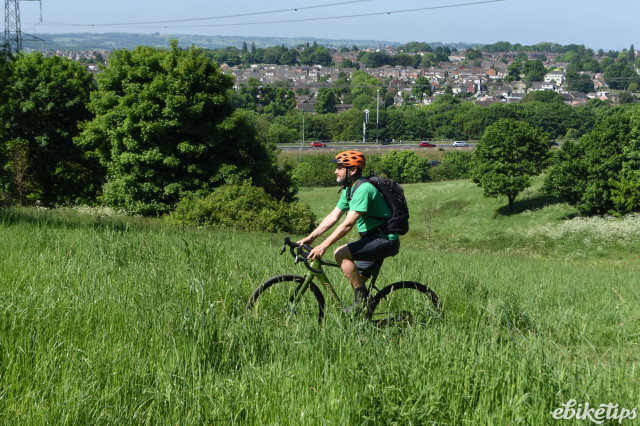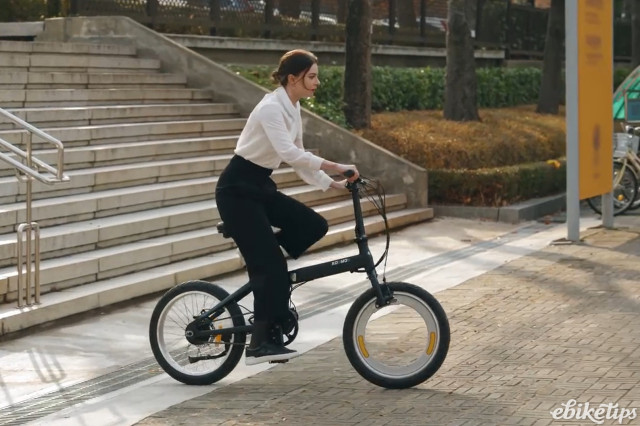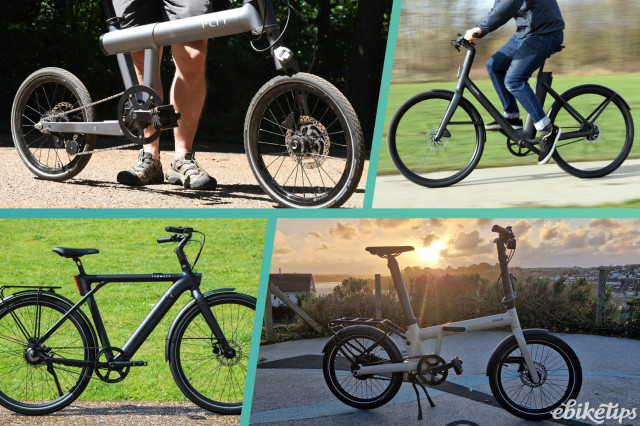Review: Advanced Offroad Pro Gravel Apex AXS

Overview
- Superb performance from the Bosch SX mid-drive
- Light but with plenty of power
- Faultless electronic gear shifting
- Battery only removable for servicing
- Not the most affordable electric gravel bike out there
German brand Advanced have been around since 2011, but more recently they have looked to develop e-bikes with more innovative technology - most notably using injection moulding to produce recyclable frames for some of their models. Whilst the 2024 version of the Advanced Offroad Pro Gravel I'm testing here uses a more conventional carbon-fibre frame and fork, it's one of the first e-bikes out there to use Bosch's Performance Line SX mid-drive.
The Performance Line SX promises plenty of high performance assistance but from a unit weighing nearly a whole kilo less than the current top of the line Bosch motor system, the Performance Line CX (the SX motor weighs around 2kg and the CX motor around 2.8kg).
Advanced say that as soon as they learned about the development of the SX motor system, in 2021, they started to build their Pro Gravel line around it.
Notably, it also features SRAM's 'entry level' Apex eTap AXS wireless, electronic derailleur shifting. For those not au fait with this concept, it completely does away with the traditional cable changing system that dominated the performance bike gear systems that came to prominence in the latter half of last century. Instead, the rear derailleur has its own battery and sensors on board and links wirelessly with gear changers incorporated into the brake levers, in traditional road bike fashion.
I'm generally a 'new electronic systems are better than old mechanical ones' sceptic. However, I'd already tried SRAM wireless shifting on a Canyon trekking model and loved it, so I was keen to see how it would perform on the Advanced Pro Gravel.
I love lightweight e-bikes too - though the trade-off is often a little less power than heavier models with bigger, more powerful motors.
At 14.3kg, the Advanced Pro Gravel is at the lighter end of the electric gravel market, so I was interested to see if my first outing on the new Bosch SX system lived up to its reputation.
Lightweight but high performance spec
Touted as a “new benchmark for lightweight e-bikes,” the Performance Line SX drive system is a mid-drive aimed at sporty riders who favour lighter weight electric mountain, gravel or urban bikes. The big selling point is its oft-quoted power-to-weight ratio and its “natural riding sensation”.
That headline weight of 2kg for the Bosch SX motor is accompanied by a claimed 55Nm of torque - mid-range in a world where the most powerful motors claim 80Nm plus, but with an impressively high peak power of 600W. (The 250W legal maximum refers to continuous output, not the peak, i.e. the level the motor can provide over a longer, sustained period of time rather than for shorter hill climbing bursts where that peak figure becomes all important).
The Pro Gravel's battery is a Bosch 400Wh unit that lives inside the downtube and can only be removed if necessary by a service centre, not on a daily basis by the rider. Whilst that might seem like a down side, on such a light bike that is relatively easy to get inside for charging, it's less of an issue than with heavier e-bikes. (You are also less likely to want to leave this £5k-plus bike unaccompanied than a cheaper e-bike.)
There is also the option to fit a 'plug and play' 250Wh range extender (Bosch call it the PowerMore 250). Whilst this was launched at the same time as the SX motor system, it is backwards compatible with some existing Smart System batteries - though not all - so check with your Bosch dealer if you want to add one to your existing setup.
One more battery aside for tech heads - the new 400Wh battery setup used on the Offroad Pro Gravel range employs larger-than-previous cells - now at 21700 format - so it is, in fact, more power dense than previous 400Wh batteries.
Bosch have been making a lot of the highest power level on the SX system. This is is where the peak power of 600W comes in and to get the most power, Bosch say it's necessary to keep up a high pedal candence - around 100rpm. In other words, spin like mad up the hills to really get the most out of this motor!
Oodles of smooth power
ebiketips first got the chance to try out the SX system at Eurobike 2023 where Rebecca reported, "Point it up the side of a small mountain like I did, and you’ve got watts aplenty to get you up there as fast or as slow and effortlessly as you want." She also added that, "having been lucky enough to ride a few lightweight mid-drives best suited to things like gravel riding, the SX is a serious contender for the best yet."
Advanced's Pro Gravel being my first experience of the off-road version of the Performance Line SX, I'd have to agree. In power terms it is significantly ahead of lightweight rear hub options typically built around the Mahle system - albeit with a weight penalty of 1-1.5kg over Mahle-equipped bikes of a similar spec.
So, the Bosch SX motor is way more powerful in it's top power modes than 'Mahle bikes' and features a 400Wh battery pack as standard versus Mahle's 250Wh offering. The real competition for the SX will come from lightweight mid-motors like the Fazua Ride 60 and the TQ-HPR50.
I've only ridden the Ride 60 on a heavier urban e-bike and without having the bikes side by side I would say the Bosch SX system definitely has more oomph (not that the Ride 60 was any slouch...)
As far as the TQ-HPR50 goes, Rebecca found the Bosch SX to be significantly more powerful - although it should be noted that the TQ motor is more geared towards being the lightest, quietest and smallest of these systems.
This perception of the power of the Bosch SX system appeared to be confirmed by the amazing hill test results of the Advanced, which sailed up both our hill climb tests in record times. It was even faster than the previous leader, a Canyon Pathlite with Bosch's Smart System adjusted for maximum power from the top of the range Bosch Perfromance Line CX - a motor that weighs around 800g more than the SX.
The conditions - unusually for our extended hill climb - provided me with a modest following wind. But still, that's a truly amazing performance from the SX system, given that it comes in at only two-thirds the weight of its more-powerful-on-paper elder sibling.
There are four riding modes: Eco, Tour, eMTB and Sprint. I found Eco was fine for easy gradients and where you wanted to put in a bit more effort. After that there was a very noticeable step-up into Tour mode and gradual increases in power until the hugely powerful Sprint mode.
I covered a mix of easy going, valley bottom riding and some demanding Pennine terrain, using a combination of on-road and not-too-bumpy off-road tracks, sticking to what I felt was the most appropriate assistance level for conditions (i.e. just enough power to give me a comfortable rather than a lung-busting workout). I estimated range from the 400Wh battery to be in the region of 35-45 miles for my 80kg frame. That's pretty efficient by any standard and very efficient for such a powerful mid-drive.
I'm no gravel riding expert, but to me the bike felt fast and agile off and on road and whilst you obviously have no suspension, there felt to be more small bump absorption in the carbon frame compared to some super stiff alloy frames.
The sporty, leant-forward riding position was partly due to the fact the seatpost won't drop right into frame (a shorter post is the obvious fix if you want a slightly more relaxed riding style). It really felt like a bike for the faster and more aggressive style of rider rather than a weekend wanderer.
One feature that all riders might well love as much as I did was the faultless performance of the wireless, cable-free electronic derailleur shifting from the SRAM Apex AXS 12-speed derailleur.
I'm not used to these wireless systems, having only tried one other iteration of it on a test bike. However, as with the SX motor system, I was hugely impressed. The bike came with the derailleur unit unscrewed to prevent damage in transit and I was worried it would be a real faff to set up and reindex, but it worked perfectly after being screwed back on without the need for any adjustment whatsoever.
More importantly, it worked without missing a beat during riding, giving crisp, quick changes over several gears at a time, as and when needed. The lowest ratio easily got me up my super-steep test climb too.
The derailleur system and change levers located on the inside of the brake levers have their own replaceable internal batteries. Having the system hardwired to the main e-bike battery would have been preferable, but the integral batteries apparently last many months and there are neat little colour-coded lights on the levers that give you loads of warning when they are starting to run low. Considering this was SRAM's 'entry level' wireless electronic derailleur system, it was hugely impressive.
This was a well-used test bike and whilst the hydraulic discs lacked some low power modulation they still provided very effective overall stopping power. I suspect new pads might have been in order to get the best out of the system, so this is probably a minor gripe.
Plenty of upgrades
There are plenty of upgrade/customisation options and Advanced say they work with bike shops with good workshop facilities who should be able to provide such one-off packages.
My test bike came with 40mm wide Continental gravel tyres but the forks will take up to 48mm width tyres for those desiring more grip and comfort. You could also fit a wireless SRAM compatible dropper post that can be controlled by pressing both brake levers at the same time - something I would have certainly found a handy upgrade.
There are rear and front mudguard mounting points and plenty of fork and frame mounting points for bikepacking additions. A potential downside is the lack of conventional mounting points for a full rear rack, but the bike will accommodate an Aeroe or Tailfin style rack.
Whilst I found the 14.3kg of my test bike manageable, Advanced told me of an 11kg customisation from one retailer that featured weight-saving options such as Hunt wheels - but of course that will come at a price
I haven't yet mentioned the 'digitally connected' aspects of the Smart system used by the Pro Gravel range. This includes full app-based smartphone mapping with voice prompts, a digital alarm, power level customisation and over the air software updates. They all work well and are reviewed more fully in my Canyon review.
It would be nice to have lower-priced Offroad Pro Gravel models without the Smart System but retaining the superb SX hardware. However, Bosch don't offer this and it's clear they see the Smart System as the future, so all future hardware will inevitably be part of the digitally connected world - whether you want it or not. Hopefully 'trickle-down' will occur and prices will drop.
Other options
Advanced also offer a flat bar version of the Pro Gravel with mechanical gear shifting and a higher spec version with a SRAM FORCE AXS wireless derailleur system.
Stepping outside of Advanced's own range, Cube are the most obvious competitors with their 2024 Nuroad Hybrid range of e-gravel bikes. We also really enjoyed the Fazua Ride 50 equipped Cairn E-Adventure Rambler (£4,289). You can find a few more options in our recent guide to the best e-gravel bikes.
In summary, if you want a light, fast, agile gravel ride with surprisingly powerful assist, coupled with impressively fast and smooth gear changing, the Advanced Offroad Pro Gravel Apex AXS should certainly be near the top of your list.































